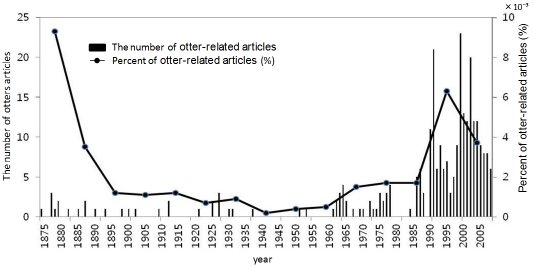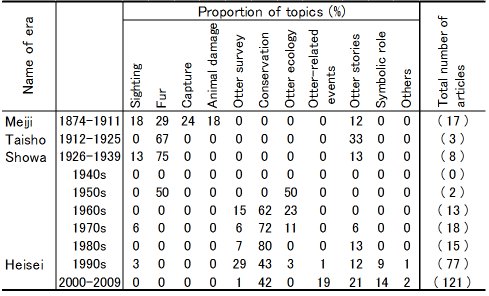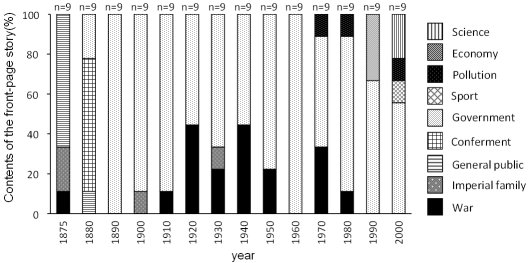IUCN/SSC Otter Specialist Group Bulletin

|
©IUCN/SCC Otter Specialist Group Citation: Yamamoto, K. and Ando, M. (2011) Trends in Otter-Related Newspaper Articles in Japan over 135 Years. Proceedings of XIth International Otter Colloquium, IUCN Otter Spec. Group Bull. 28B: 31 - 35 Trends in Otter-Related Newspaper Articles in Japan over 135 Years Kayoko Yamamoto1 and Motokazu Ando2
1Official of Imperial Prince's Household Affairs Division, Imperial Household Agency, Japan |

 |
| (Received 13th October 2011, accepted 6th March 2012) |
|
Abstract: To understand the chronological change in people’s interests and attitudes toward the Japanese otter, which became extinct during the 1990s, the number and contents of otter-related newspaper articles over 135 years were investigated. This investigation shows that, in the consciousness of people, the otter shifted gradually from being the animal of a neighborhood in the 19th century, economic value in the early 20th, conservation need in the late 20th, and symbolic value after 2000. Presently, the number of otter articles is progressively decreasing owing to a lack of news. |
| Keywords: Japanese Otter, extinction, social attitudes, journalism |
| Française | Español |
At the time of the Meiji Restoration (1868), when Japan opened its markets to the western world, the Japanese otter was widespread. Although there are indications that the Japanese otter might be a distinct species Lutra nippon (Suzuki et al., 1996; Imaizumi and Yoshiyuki, 1989), according to the recommendation of Klaus-Peter Koepfli, the OSG regards it as Lutra lutra and suggest that it should not be classified as a 14th species until evidence is improved. This modernization caused a drastic decrease in otters, which became extinct in the 1990s (Ando, 2008). To understand the chronological change in people’s interests and attitudes toward the otter, the number and contents of otter-related newspaper articles over 135 years were investigated through an analysis of newspaper databases.
METHOD
Articles of Yomiuri, a national paper in Japan, during 1874–2000 that contained words meaning “otter” were retrieved from its database “Yomidasu-rekishikan.” Two local papers at Shikoku Island, where the otter was last seen, were also investigated using their microfilms: From Ehime dated 1950 to July 1997 and from Kochi from 1950 to May 1992. “G-search,” a general database, was used to retrieve recent information: from Ehime dated August 1997 to 2009 and from Kochi dated June 1992 to 2009. Supplemental interviews of aged persons at Shikoku were conducted to understand their consciousness of the otter.
CHANGE OF ARTICLE NUMBERS
A total of 276 otter-related newspaper articles were retrieved from Yomiuri (Fig. 1). The frequency of otter-related articles was rather constant until the 1950s. The frequency started to increase from the 1960s, when the otter was threatened by environmental deterioration owing to high economic growth and was designated as a Special Natural Monument animal in 1965. In the 1990s, although the otter became extinct, the number of otter articles oddly increased since the fact of their extinction was unknown. From 2000 until today, the number of otter articles progressively decreased owing to lack of news. As the number of articles about otters is influenced by the total newspaper articles, the ratio of otter articles to the total number of articles was also examined (Fig. 1). This comparison implied that the relative abundance of otter-related articles was highest in the 19th century. Similar horseshoe-shaped patterns were also identified in articles concerning other animals, such as the wild boar (Sus scrofa) and the albatross (Phoebastria albatrus).
 |
| Figure 1.
Number of otter-related articles and the ratio of otter-related articles in total articles of Yomiuri in 1874–2009 Click for larger image |
CHANGE OF ARTICLE CONTENTS
In the Meiji era (1868–1912; the age of wealth and military power policy), the numbers of Japanese otters decreased sharply owing to indiscriminate hunting for pelt exports and military demand. However, such issues were not raised in newspaper articles of Yomiuri. Instead, the articles mainly dealt with otter encounters near human habitats, suggesting that the otter was still common (Table 1). In the Taisho era (1912–1926; the age of democracy), the actual otter population also continued decreasing, and in 1928, the otter was removed from the list of game animals. At this time, about 70% of otter-related articles focused on the topic of fur (Table 1). Among article titles were ones about the increase in fur prices and escalating demands for otter fur. Between the early Showa era (1926–1945; the age of totalitarianism and militarism) and post-WWII reconstruction (1945–1955), there were only 10 articles concerning otters. Otter-related articles almost disappeared not only from papers but also from other statistics and reports. During the successive economic growth period (1955–1973), the otter population progressed to the brink of extinction due to environmental deterioration (Machida, 1997). In the 1960s Yomiuri started to appeal for otter conservation. During the 1960s–1980s, about 70% of otter-related articles focused on conservation (Table 1). Conservation was still a dominant topic in the 1990s although there had been no record of the otter for more than a decade. After 2000, the name of “otter” often appeared on the scene of events for regional development and environmental protection as a symbol of healthy environments (Table 1).
| Table 1. Proportion of topics (%) on otter-related newspaper articles of Yomiuri in 1874–2009. Click for larger image |
 |
In Ehime, a local paper, the otter made an appearance in the 1950s as an endangered species, that was earlier than the case of Yomiuri, a national paper. In Kochi, however, needs of otter conservation firstly appeared in the 1970s after a delay of a decade. The number of otter articles in local papers was not different from those of the monkey (Macaca fuscata) and the wild boar, indicating that the otter was not a special animal to humans. Interviews of local people indicated that they were familiar with the otter. Folk stories that the otter stole from people were commonly known. But people were not conscious of the otter decline in 1960s–1970s. Moreover, fishermen did not like otters because they stole cultured fish. Accordingly, local people did not have a sense that otter protection was necessary. After 2000, contents of otter-related articles in local papers also shifted from conservation need to symbolic value.
To place the otter articles in the overall social backgrounds, headline news of Yomiuri in respective decades were investigated (Fig. 2). It is noteworthy that war-related articles increased from the 1920s and 1940s, indicating that Japan went on war footing. This wartime regime coincided with the period in which otter-related news became scarce, as seen in the proportion of otter-related articles in Fig. 1. The reasons would be that people became unable to afford the luxurious otter fur under the state-controlled wartime economy, and that military fur demand for fur shifted from wild-captured animals to farmed ones such as the rabbit (Oryctolagus cuniculus) and the nutria (Myocastor coypus). War-related articles also increased in the 1950s, 1970s and 1980s, but they were respectively on the Korean War, the Vietnamese War and the Iran-Iraq War that broke out overseas.
 |
| Figure 2.
Content of headline news on Yomiuri as an indicator of social atmosphere Click for larger image |
DISCUSSION
From the above facts, the association of Japanese people with the otter can be divided into four phases: 1) familiar animal in the Meiji era, 2) economic value in the Taisho era, 3) no interest in war time, 4) needing protection during the high economic growth period, 5) symbolic value after its extinction. This change of otter–human relationships (from familiar animal to almost forgotten animal) was commonly observed in other national and local papers. Such a change has been reported for the Oriental white stork (Ciconia boyciana), one of the critically endangered birds in Japan (Kikuchi, 2006). It was a “hunted bird” in the early Meiji era, a “bird of happiness” in the middle Meiji era, a “protected bird” in the late Meiji/Taisho era, an “agricultural pest bird” in the early Showa era, a “forgotten bird” in post-WWII, and again “a protected bird” in the 21st century. This indicates that such a change of social attitudes might be common in many endangered species. An important lesson is that local people were indifferent to the otter in the 1960s when effective conservation measures for wild populations had to be taken. Newspaper articles do not seem to have functioned as an early warning tool for promoting otter conservation. Moreover, recent decrease of the otter-related news indicates that conservation actions including re-introduction are necessary before the otter totally fades out from the memory of people.
REFERENCES
Ando, M. (2008). The Japanese otter - lessons from its extinction. University of Tokyo Press, Tokyo, 233pp. [in Japanese].
Kikuchi, N. (2006). Reviving the oriental white stork: a reintroduction project for local community sustainability. University of Tokyo Press, Tokyo, 276pp. [in Japanese].
Imaizumi, Y. and M. Yoshiyuki. (1989). Taxonomic status of the Japanese otter (Carnivora, Mustelidae), with a description of a new species. Bulletin of the National Science Museum Tokyo Series A 15: 177-188.
Machida, Y. (1997). Tosa and the Japanese otter. In ‘Hello Japanese otter !’ (Kochi Shinbun Press, ed.), pp.34-62. The Kochi Shinbun, Kochi. [in Japanese].
Suzuki, T., Yuasa, H., Machida, Y. (1996). Phylogenetic position of the Japanese river otter Lutra nippon inferred from the nucleotide sequence of 224 bp of the mitochondrial cytochrome b gene. Zoological Science. 13: 621-626.
Résumé : Bilan des Articles de Journaux Consacres à La Loutre au Japon depuis 135 Ans
Pour comprendre l'évolution chronologique de l'intérêt des gens et de leur attitude envers la Loutre japonnaise qui s'est éteinte au cours des années 1990, le nombre et le contenu des articles de journaux consacrés à la Loutre depuis 135 ans ont été étudiés. Cette enquête montre que, dans la conscience des gens, la Loutre est passée progressivement d’un animal de quartier au 19e siècle, à une valeur économique au début du 20e, au besoin de sa conservation à la fin du 20e pour finir comme symbole après l'an 2000. À l'heure actuelle, le nombre d'articles sur la Loutre diminue progressivement en raison d'un manque de données nouvelles
Revenez au dessus
Resumen: Tendencias en Artículos de Prensa Relacionados con Nutria en Japón a través de 135 Años
Para comprender el cambio cronológico en los intereses y las actitudes de las personas hacia la nutria japonesa, que se extinguió durante la década de 1990, el número y contenido de artículos de prensa relacionados con la nutria fueron investigados durante 135 años. Esta investigación muestra que, en la conciencia de la gente, la nutria se desplaza gradualmente de ser el animal de un barrio en el siglo XIX, el valor económico en el temprano siglo XX, las necesidades de conservación en los finales de siglo XX y el valor simbólico después del año 2000. Actualmente, el número de artículos sobre nutria está disminuyendo progresivamente debido a la falta de noticias.
Vuelva a la tapa